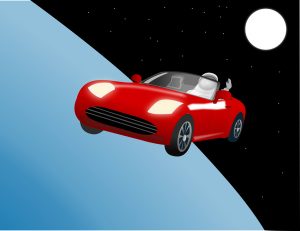 It’s been over a year since SpaceX launched its Tesla Roadster vehicle into space. On Feb. 6, 2018, the aerospace manufacturing company launched the Tesla Roadster, complete with a dummy astronaut, aboard a Falcon Heavy falcon from the Kennedy Space Center in Florida. Since then, the all-electric vehicle has completed a full trip around the sun.
It’s been over a year since SpaceX launched its Tesla Roadster vehicle into space. On Feb. 6, 2018, the aerospace manufacturing company launched the Tesla Roadster, complete with a dummy astronaut, aboard a Falcon Heavy falcon from the Kennedy Space Center in Florida. Since then, the all-electric vehicle has completed a full trip around the sun.
As reported by TechCrunch, SpaceX’s Tesla Roadster has officially completed a full trip around the sun. You might be wondering how far, exactly, the Roadster has traveled. Well, there’s a website where you can learn more about this spacefaring all-electric vehicle. Known as WhereIsRoadster, the website offers real-time data on SpaceX’s Tesla Roadster. According to WhereIsRoadster, as of writing this, the Roadster has traveled over 813 million miles, which is pretty impressive considering that it comes with just a 36,000 mile warranty. The website goes on to say that SpaceX’s Tesla Roadster has traveled the equivalent of all the Earth’s road by 36 times.
If you watched SpaceX launching the Tesla Roadster into space last year, you may recall the private aerospace manufacturing company livestreaming the project. It was one of the most-watched aerospace events in the past decade. During the launch, SpaceX turned on the Roadster’s radio to play “Life on Mars” by rock legend David Bowie. SpaceX even installed cameras inside the Roadster to stream footage back to Earth so that everyone could experience this historic event.
SpaceX’s initial launching of the Tesla Roadster was a critical momentum for the private aerospace manufacturing company. This was the first time SpaceX had ever tested its Falcon Heavy Rocket. As you may know, the Falcon Heavy is a reusable rocket designed and manufactured by SpaceX. It’s based on the aerospace manufacturing company’s previous Falcon 9 rocket, but with a few notable upgrades. The first stage of the Falcon Heavy rocket is stronger and more powerful than that of the original Falcon 9. Furthermore, the Falcon Heavy rocket has two extra first stages using strap-on boosters.
With its strap-on boosters, the Falcon Heavy rocket is able to gracefully land back on Earth. Unlike other rockets, it doesn’t just fall back to Earth using a parachute. Once the Falcon Heavy rocket has delivered its payload in space, the strap-on boosters engage, thereby gliding the Falcon Heavy rocket back down to Earth. It’s important to note that while the Falcon Heavy rocket certainly holds promise for the aerospace manufacturing company, SpaceX is already planning to replace it with the Starship and Super Heavy Launch system.



